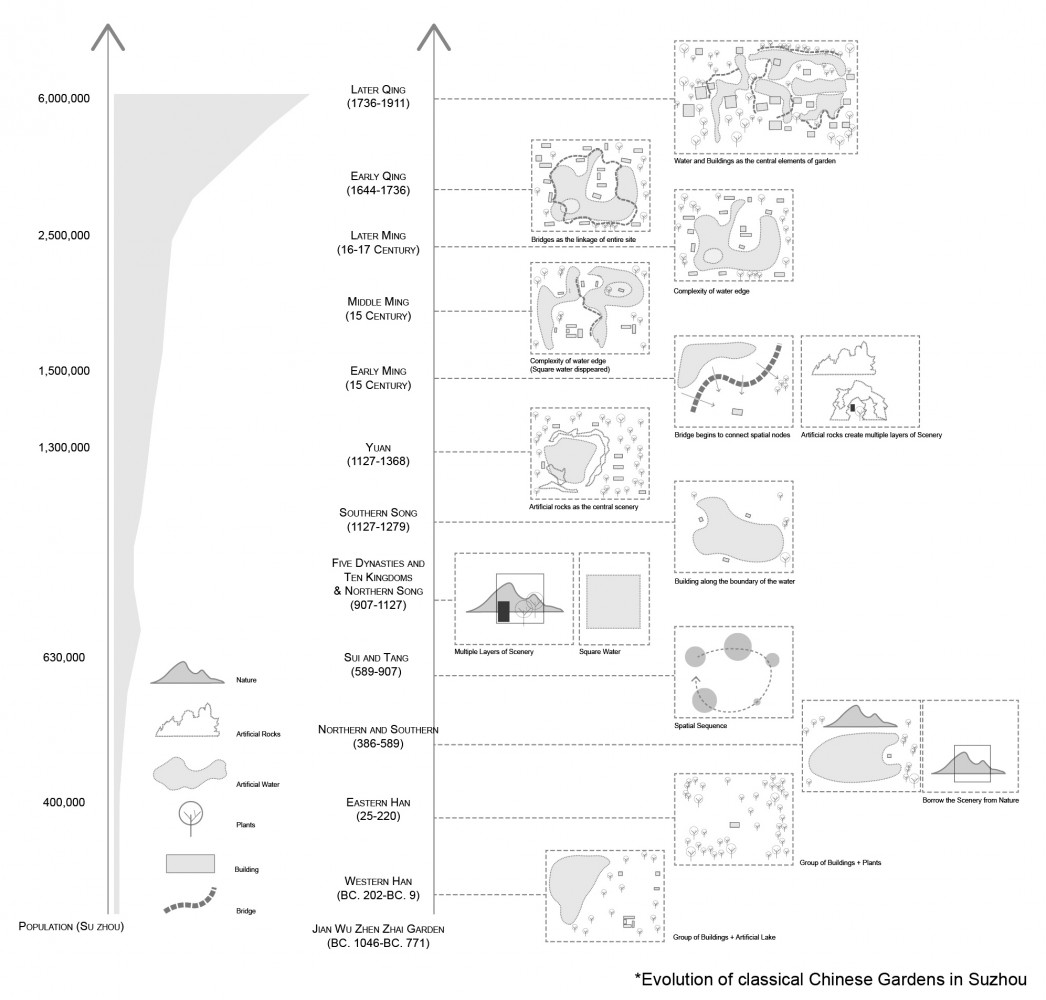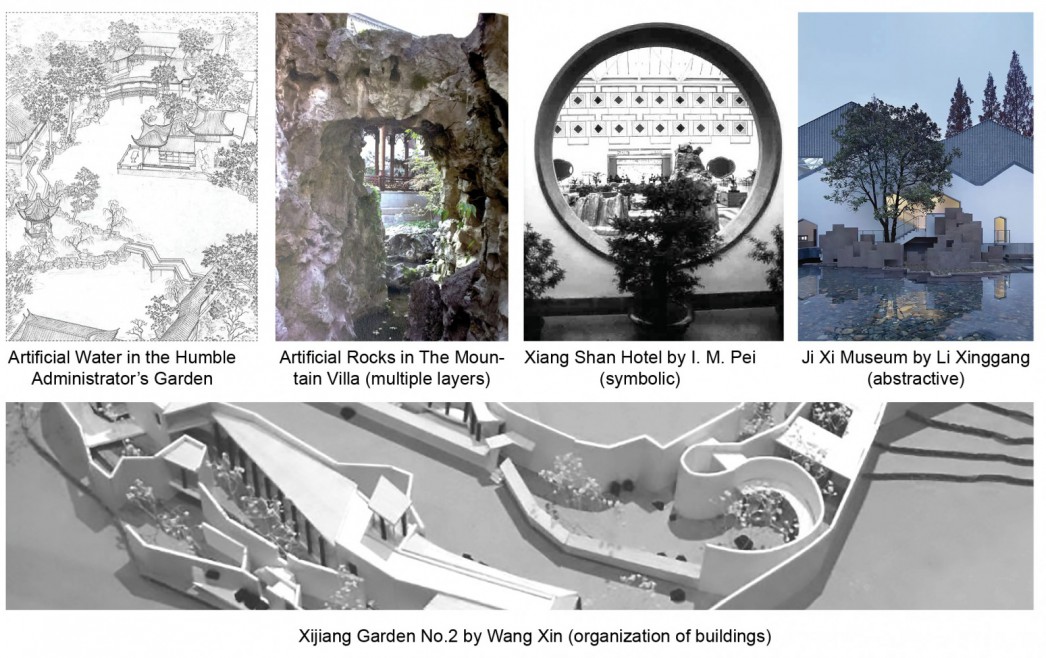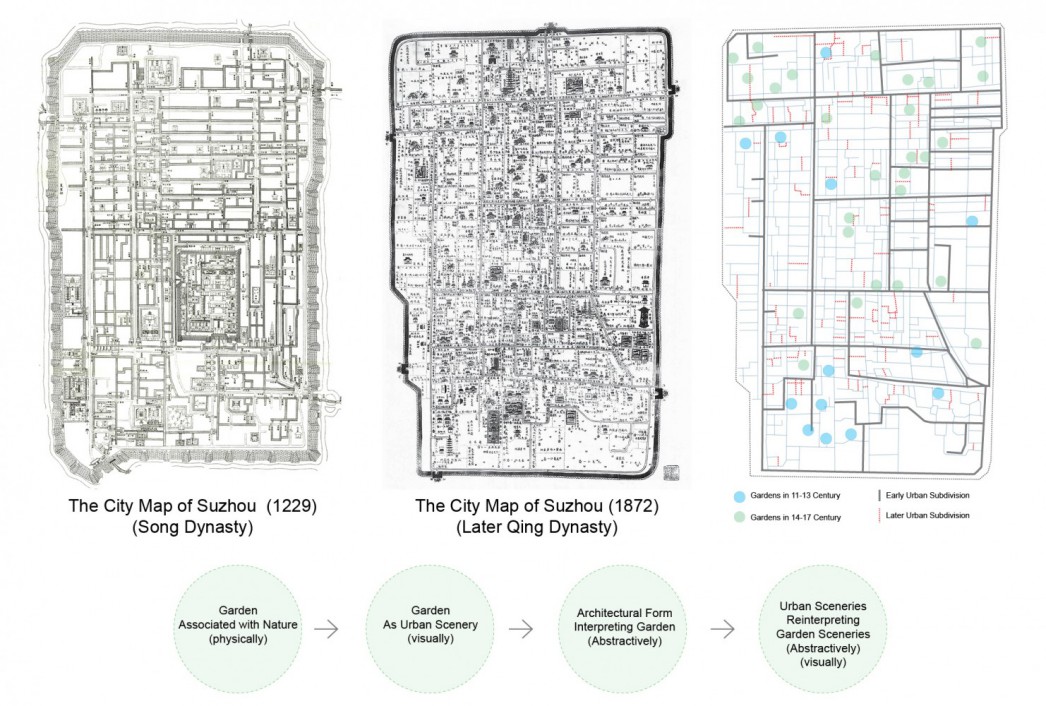URBAN DENSIFICATION & GARDEN INTERNALIZATION 3.0
|
This thesis explores and investigates the future design of urban landscape architecture in Suzhou inspired by the evolution of classical Chinese gardens with the essence of urban scenery in ancient China through the urban densification process. It innovates because it is not only on the basis of strategies and methodologies of Chinese gardens in maturity stage but also trying to utilize the architectural language to translate the philosophy in high-density urban scale. Incorporating the overlaying mapping of different elements of Chinese garden, deconstructive collage of sceneries and analysis of figure–ground relationship, this thesis begins with the research of Chinese garden in terms of its internalization process through urbanization to figure out how different elements organize together into a whole experience and play as several groups in certain spatial nodes, and then attempts to push the urban condition to extreme and to test the multiple possibilities of design of landscape architecture in the very dense and limited urban scale to create infinite experience. WHAT? This thesis is about the future design of landscape architecture integrated into the high-density urban environment in Suzhou by translating the language and sceneries of classical Chinese gardens. It includes three stages: Research stage: This thesis investigates the future of the garden space from urban perspective and thus chooses Suzhou as the site to research. The study starts from the analyses of the generation of Jiangnan garden vocabulary from the urbanization aspect, especially the influences on the evolution of gardens in the Ming and Qing Dynasties of the increase of urban density, the raise of population, the subdivision of urban grid, the narrow of garden land-use and the changes in streets, and further maps out the limitation, potential and challenge of the currently high-density environment in urban space to the development of garden space in the future. Test stage: On the research basis, this thesis attempts to proceed the garden language test from the perspective of element organization and visual connection in the selected site and in the urban space with new architecture to do the re-organization and the abstract re-interpretation of the garden space organization methodologies of waterscape, building, rockery, vegetation and bridge and the construction methodologies of the scenery with different layers. The test also attempts to investigate and translate the methodologies of classical gardens such as main feature and secondary feature, obstructive scenery and upgraded scenery, actual view and virtual view, vista line and framed scenery, front view and background, top-down view and bottom-up view, existent scenery and borrowed scenery, and seasonally generated sceneries from tinny to large scale. Site of this project locates in Ping Jiang Road, Suzhou. Size of the site is close to the stream and around 15,000 km2 that contains high-density urban environment and both open and closed urban interfaces. This site also has various visual connections with surrounding buildings and directions of pedestrians. Production Stage: Output of this design will be a landscape architecture in high-density urban condition. The landscape architecture will contain integrated landscape space and exhibition function focusing on how the pedestrians and urban sceneries are designed as the continued elements from the urban space into the site. WHY? In the past: before the Song Dynasty, urbanization level was low in China. In garden designs, land-uses were unrestricted and spaces were relatively comfortable and open. The Song Dynast was in the beginning period of urbanization of the ancient China, and land-uses of classical gardens started to exhibit some enclosed characteristics. For example, the Canglang Pavilion built in the Northern Song Dynasty was constructed in suburbs and therefore could still integrate with the natural surroundings. Classical garden works built in the Yuan Dynasty such as the Jichang Garden in Wuxi, mountain views of the site were skillfully borrowed in the internalized garden and therefore rich experience was generated. In the Ming and Qing Dynasties, urbanization levels were relatively high and urban population increased dramatically at the same time, these two dynasties were the main development periods of the Jiangnan Gardens. Due to the increase of urban density and tight land-use, Chinese gardens exhibited significant internalization feature and attempted to create unlimited interaction experience in limited spaces and to integrate people, architecture and environment into one picture, for example, the Humble Administrator’s Garden built in the Ming Dynasty and the Master of Nets Garden built in the Qing Dynasty. At that time, theories of classical Chinese gardens have reached the climax. At present: many architects attempt to incorporate and utilize the philosophy and language of classical Chinese gardens to achieve their own architecture and landscape designs and generate rich spatial experience in limited environment. For example, I.M. Pei’s Xiangshan Hotel attempts to abstract the garden elements by signal language and to integrate the garden with the large building; the Xiangshan Campus of China Academy of Art by WANG Shu attempts to create continues walking space to generate the “a scene one step” garden spatial experience; the Garden of Red Brick by DONG Yugan attempts to link the interior and exterior behaviors of the building to generate multi-level visual connections of garden; and the Jixi Museum by LI Xinggang integrates the garden vocabulary with the layout of courtyard, etc. For my proposition: considering that although above designs translated the language of classical Chinese gardens, they were mainly achieved in a single building or an independent building group. On the basis of above thoughts and practices, this thesis attempts to explore the continuation of spatial philosophy of Chinese gardens in high-density urban scale from the urban perspective and further considers how the internalized and intensive garden language in maturity period create infinite spatial experience in the more extremely limited urban space and establish connection with urban context, and therefore improves the quality of ordinary people’s living environment. HOW? The feature of classical Chinese garden is about its rich spatial experience by element organization and scenery creation. Mapping method, more specifically, overlaying mapping of different elements of Chinese garden, deconstructive collage of sceneries and analysis of figure–ground relationship will benefit the research, test and production stage. The research will map out: the densification process of Suzhou and features exhibited in each stage in the evolution process of classical garden. And it will map out the different typical garden design methodologies. The test stage will utilize these above tools to experiment the different possibilities of new organization and sceneries on the site. The production stage will push the research and test into a practical design on site. Step 01: Research of the relation between the increase of urban density and the evolution of gardens forms; materials collections and relevant study readings; Confirmation of the site (Due 21 Dec.). BIBLIOGRAPHY Historical Records: Theories: Projects: |


